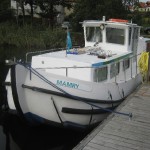After a peaceful but chilly night – there was frost on the mooring pontoon first thing the next morning 🙁 , we set off from Gizycko, to cruise to the northern navigable extremity of the Masurian Lakes, the town of Wegorzewo.
There are two possible ways to cruise northwards to Wegorzego. We chose to take the shorter route which involves passing along a canal through the town of Gizycko. On this route, there is a nineteenth century swing bridge which is only open at certain set times. We set out from Ekomarina, in order to be at the swing bridge when it opened at 10.35 that morning.

On entering the canal, we first passed under this railway bridge which has sufficient headroom.

Then came the swing bridge.

We arrived a few minutes early. But when it was10.35, the light initially remained red as no less than four boats were first allowed through, travelling in the opposite direction! The only boat traffic jam we ever experienced during our time on the Masurian Lakes 🙂

Then it was our turn…..

After passing through the canal, first we cruised northwards on Lake Kisajno, before reaching the wide expanse of Lake Dargin. Here we had the whole lake to ourselves, with the exception of one small fishing boat.

We then passed under this bridge and a narrower channel that followed, to take ‘Mamry’ onto Lake Mamry, or the Mauersee as it is known auf Deutsch. An aerial photograph of this bridge is widely used to promote tourism on the Masurian Lakes. I saw it featured on an advertising poster displayed in the Prague Metro a couple of years ago, which first stimulated my interest to explore this area.

Just one example of the variety of bird life we saw on the Masurian Lakes.
 |
 |
We reached Wegorzego early in the afternoon, and having found and paid for a suitable mooring in the port, we set off to explore the town. After a most enjoyable late lunch, we visited this Church, dedicated to St Peter & St Paul.
The whole Masurian Lakes area lie in what was formerly East Prussia, part of the German Reich until 1945 and predominantly Protestant. Under the Potsdam agreement, the borders of Poland moved westwards and this part of East Prussia was absorbed into the Polish state, with the German population being expelled.
As a plaque in the porch explained, (in Polish 🙂 ), this Church building had belonged to the Lutheran Church of the Augsburg Confession until 1945. Following the expulsion of German Protestants, it had been taken over by the Roman Catholic Church. Whilst its exterior remains fairly plain, the interior has been romanised! New stained glass windows have also been installed of which this is an example.
The next morning, Tuesday 13th October, we decided to have a long day of cruising, and return to Mikolajki. It had taken us around four hours to cruise from Mikolajki to Gizycko and around three hours to cruise from Gizycko to Wegorzego. Therefore, it should be perfectly possible to cruise from Wegorzego to Mikolajki in no more than seven hours which proved to be the case. We left Wegorzego at 09.10, and reached Marina Miko in Mikolajki, just after 16.00.

However, our return journey was not without incident, Early in our cruise that day, we passed this yacht. But rather than navigate again through the centre of Gizycko and wait for the opening of the swing bridge, we chose to use the alternative route west of the town. This involves cruising further south on Lake Kisajno, and then passing along a short canal under both a road bridge, followed by a railway bridge, before entering Lake Niegocin.
Whilst navigating this canal, we twice made contact with the canal bottom, even though I tried to remain right in the centre of the waterway. Clearly this was because of the low water levels we had been told about before setting out, though this canal had not been designated as one to avoid.
This second problem was that, once we were out of the canal and onto Lake Niegocin, there ceased to be a buoyed channel to follow, even though it had been there, two days previously! Magda had warned us that, from Thursday 15th October, the navigation authorities might start to remove the buoys for the winter. But this was Tuesday 13th October! So we navigated south across the lake, guided only by our map and visible geographical features.

When we arrived near to Rydzewo, at the southern end of the lake, we found the culprits!

We cruised further south through Lake Jagodne, where both green and red buoys were fortunately, still marking the correct channel. Then it was back through the four relatively short canals linking three lakes……

……before heading south along Lake Talty and returning to Mikolajki.



It seems your trip was not lacking in adventure, Ricky! It’s a good thing you are skilled with maps.
I appreciate how you imbue your posts with historical information; I learn a lot when I read them. The information about the church is very interesting.
We could have done without the navigation authority, removing the buoys on Lake Niegocin and not telling anyone in advance that they were going to do so. But it’s what you get for late season cruising 🙂
As with any country, I think it’s important to know some history, as it gives you much greater understanding of what you see as you travel. This is especially the case with Poland when the borders of the country have changed several times during different periods of history.